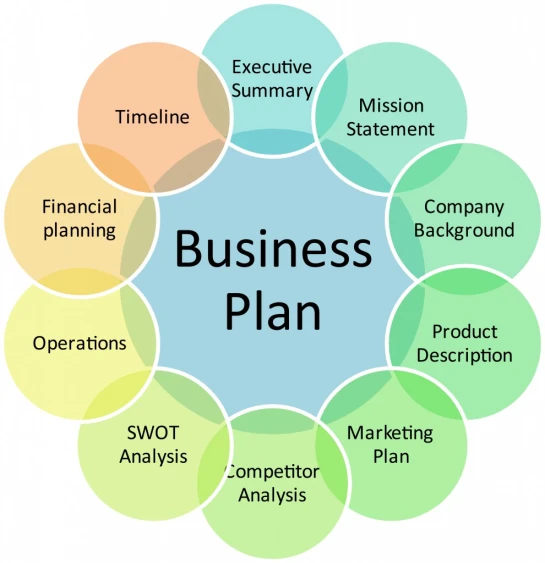
- jaro education
- 29, February 2024
- 10:00 am
What is a Business Plan?
A business plan is a comprehensive document encapsulating the operational and financial strategies of a business, articulating the methodologies through which its goals and objectives will be accomplished. This essential document serves as a navigational guide for the business, delineating a clear path toward success. It holds particular significance when presenting the business to potential investors or financial institutions and serves as a compelling tool for soliciting debt or equity financing.
Within its pages, a well-constructed business plan outlines the fundamental aspects of the business, from its mission and vision to the intricate details of how it intends to thrive in the market. It serves as a blueprint that not only illuminates the present state of the business but also provides a forward-looking perspective, anticipating challenges and strategically addressing them.
The business plan acts as a tool for communication and alignment within the organization, ensuring that all stakeholders, from management to employees, are on the same page regarding the business’s objectives and the means to achieve them. Whether seeking financial support or steering the company toward growth, a robust business plan is an indispensable asset in the arsenal of any business leader.
This comprehensive guide aims to provide an insightful introduction to business planning by providing guidance on how to make a business plan, as well as templates and examples to help with the process.
In one form, the power supply is processed using control mechanisms and semiconductor switches. While the common applications of power electronics are switch-mode, where efficiency, power density and reliability are of prime importance, motor control is honing with more electrification in transportation systems. Simply put, when it comes to power electronics control, efficiency and control are of prime importance.
Table of Contents
If you want to have relevant experience in the field of electrical engineering, then apply for the Advanced Programme in Electric Vehicle (EV) Technology Programme offered by CEP, IIT Delhi. It is a 6-month course that helps understand power electronic control comprehensibly. You can register for the programme with Jaro Education to get an in-depth understanding of the subject.
Understanding the Significance of a Business Plan
Prior to the creation of a business plan, it is crucial to comprehend its fundamental purpose. The development of a business plan serves three primary objectives:

*trinitycollegestage2media.wordpress.com
1. Establishing Business Focus
The foremost purpose of a business plan lies in charting the course for your future endeavors. This involves setting clear goals or milestones, accompanied by meticulous steps outlining how your company will attain each objective. The process of creating this roadmap not only defines your business focus but also provides a strategic framework for pursuing sustained growth.
2. Securing Funding
A well-researched business plan stands as a prerequisite when seeking investment from private investors, banks, or other lenders. Prospective investors seek insights into your business operations, revenue and expense projections, and, crucially, how they will reap returns on their investment. The business plan thus serves as a key tool in instilling confidence and demonstrating the viability of your business.
3. Attracting Executives
As your business expands, the need to augment your team with skilled executives becomes inevitable. A meticulously crafted business plan plays a pivotal role in attracting executive talent. It serves as a comprehensive document that provides potential executives with a clear understanding of your company’s vision, mission, and strategic direction. This facilitates informed decisions about whether they align with the company’s ethos and objectives.
Components of Business Planning
Business planning guides you along the journey of growing a company. Referring to one will keep you on the path toward success. And if the business plan is compelling enough, it can also convince investors to give you funding. Typically, a business plan is a document that will detail how a company will achieve its goals. The components of a business plan and tips for how to write a business plan are as follows:

*wisebusinessplans.com
1. Executive Summary
The executive summary holds a pivotal role in the business plan and is the most crucial section. Functioning as a concise introduction, its purpose is to captivate readers’ attention and serve as a guiding beacon throughout the comprehensive document, which can span dozens or even hundreds of pages. Typically, executive summaries feature key elements like the mission statement, company history and leadership, a snapshot of competitive advantages, financial projections, and overarching company goals. It is imperative to maintain clarity and brevity in the executive summary, presenting only the most essential insights.
2. Business Description
The segment dedicated to providing an overview of your business within the business plan plays a crucial role in introducing your company in a manner that is both compelling and concise. This section aims to encapsulate vital elements such as your business name, the duration of your operations, the key products or services you offer, a positioning statement that articulates your unique market stance, and, where applicable, the core values that underpin your business ethos.
3. Product and Price
This section involves a comprehensive examination of the cost structure and diverse revenue streams. The business plan delves into specific pricing breakdowns for each product or service, elucidating the rationale behind the pricing in comparison to industry competitors. If the pricing is higher, it explicates the value proposition that justifies customers paying more. Conversely, if the pricing is lower, the plan elucidates the operational efficiencies enabling cost-effectiveness. Furthermore, it outlines projections for breaking even, expected profit margins, and relevant financial milestones.
4. Competitive Analysis
Exploring market dynamics, it’s vital to spotlight key competitors in your business plan. In a marketplace where customers have numerous brand options, decoding the factors influencing their choices is important. This section unveils insights into competitor allure, providing a strategic edge to understand customer preferences effectively. Performing a competitive analysis can help you uncover:
- Industry trends that other brands may not be utilising
- Strengths in your competition that may be obstacles to handle
- Weaknesses in the competition that may help in developing selling points
- The unique proposition one should bring to the market should resonate with customers
5. Target Market
This segment will intricately outline the customer segments, delving into the demographic and psychographic details of the audience. If the immediate response is a broad “everyone,” a deeper exploration is necessary. The critical questions to ponder are: Which demographics are inclined to require or purchase the product or service? What characterises the psychographics of this audience, considering their desires and triggering events? The value of the offerings to this specific audience should be clearly articulated. Constructing a buyer persona proves beneficial, aiding in adopting the perspective of ideal customers and elucidating the targeted approach.
6. Marketing Plan
In this step, the primary emphasis lies in cultivating new customer relationships through the elucidation of a comprehensive marketing strategy. The narrative intricately weaves together crucial elements, including the brand’s positioning vision and the strategies employed to nurture it. A key aspect involves articulating the brand vision in a manner that resonates with the target audience, effectively appealing to their preferences and needs. Additionally, the discussion encompasses well-defined goals, the metrics utilised for success, and the channels, along with distribution tactics, that have been strategically adopted. This section seamlessly integrates with earlier components, such as the identification of the target audience and competitive analysis, ensuring a cohesive and strategic narrative.
7. Team
Following the delineation of your objectives, substantiation of your business opportunity, and scrutiny of the industry terrain, the team segment in your business plan delineates the individuals accountable for realising your goals. Even in the absence of your complete team at this juncture, investors will be duly impressed by your perspicuous comprehension of the roles awaiting fulfilment.
8. Financial Plans
In this section, investors and leadership teams can gain crucial insights into funding strategies and investment opportunities. According to Forbes, three essential components should be incorporated:
Profit/Loss Statement
This component addresses the question of the business’s current profitability, providing a financial overview.
Cash Flow Statement
A detailed account of cash inflows and outflows, offering insights into the business’s liquidity and available cash reserves.
Balance Sheet
An outline of assets, liabilities, and equity, offering a comprehensive view of the business’s overall worth and financial structure.
While variations may exist in the depth of information included in different business plans, these key financial statements provide the necessary foundation for assessing the financial health and value of the business.
9. Funding Requirements
Funding requirements constitute a pivotal aspect of a business plan, serving the overarching objective of securing financial support from potential investors. It is imperative to elucidate the precise amount of funding sought, provide a comprehensive rationale behind the necessity for these funds, and articulate the specific duration for which the financial infusion is required. In doing so, a well-crafted business plan not only apprises investors of the capital imperative for operational efficacy but also offers a strategic insight into the temporal dimensions of financial utilisation.
Types of Business Plans for Entrepreneurial Triumph
In the intricate landscape of business, a well-crafted business plan serves as an indispensable roadmap for entrepreneurs. Two predominant types of business plans, each tailored to specific needs, play pivotal roles in guiding ventures through the complexities of the entrepreneurial journey: the lean startup plan and the traditional business plan.
1. Lean Startup Business Plan
Originating from the insights of business model expert Ash Maurya, the lean startup business plan, often embodied in a lean canvas, adopts a streamlined approach to encapsulate the essence of a business concisely. Introduced in 2010, it has endured as a preferred choice for its brevity and focus on key metrics crucial for engaging with investors.
Components of a Lean Startup Business Plan
Problem
Identifying the core issue the business aims to address.
Solution
Outlining the proposed resolution to the identified problem.
Key Metrics
Highlighting essential metrics crucial for evaluating business performance.
Unique Proposition
Articulating the distinctive value proposition that sets the business apart.
Unfair Advantage
Showcasing unique advantages or strengths providing a competitive edge.
Channels
Defining the avenues through which the product or service reaches customers.
Customer Segments
Clearly defining the target audience or customer segments.
Cost Structures
Detailing the various costs associated with operating the business.
Revenue Streams
Identifying sources of revenue and income for the business.
A lean canvas efficiently condenses this vital information onto a single page, offering a swift, comprehensive overview suitable for effective communication with investors.
2. Traditional Business Plan
In contrast, traditional business plans are comprehensive documents, often spanning 30 or 40 pages. Serving as a blueprint for the entire business journey, these plans delve into extensive details about various facets of the enterprise.
Key Components of a Traditional Business Plan
Executive Summary
A concise overview of the business, summarising its goals and objectives.
Company Description
In-depth information about the nature, mission, and vision of the business.
Products and Services
Detailed descriptions of the offerings and their value to customers.
Market Analysis
Thorough examination of the market, including competitors and target demographics.
Management Team
Profiles of key personnel and their roles in steering the business.
Financial Plan
Comprehensive financial projections, including income statements and balance sheets.
Operational Plan
Detailed insights into the day-to-day operations and processes.
Appendices
Additional supplementary materials supporting various aspects of the business plan.
Traditional business plans provide a comprehensive outlook, offering detailed trajectories from the launch of the business to its envisioned establishment over several years.
Case Studies of Companies with Successful Business Plans
Certain companies stand out for their innovative approaches and successful execution of business models. Two such examples are Mamaearth and JioMart, both contributing significantly to the Indian consumer goods and e-commerce sectors, respectively.
Mamaearth: A Toxin-Free Revolution
Mamaearth, established in 2016 by Ghazal Alagh and Varun Alagh, has rapidly emerged as a leading Indian brand offering toxin-free baby care, skincare, and hair care products. The company’s success can be attributed to its focused business model and strategic marketing initiatives.
Target Audience and Product Range
Mamaearth initially targeted mothers and their babies, providing a range of baby care, pregnancy care, and skin and hair care products. Over time, the company expanded its customer base by appealing to millennials with chemical-free skincare products and catering to men with products like aftershave lotions and beard oils.
Business Model
Mamaearth’s business model is straightforward; the company formulates products, and contract manufacturers produce them under the Mamaearth brand. The company primarily sells through Direct-to-Consumer (D2C) channels such as Amazon and Flipkart, ensuring an omnichannel presence.
Connecting with the Target Audience
Mamaearth’s success lies in its ability to connect with its target audience – mothers. The founders, having experienced the challenge of finding toxin-free baby products themselves, understood the needs of parents. This resonated in their advertisements and marketing strategies.
Product Quality and Innovation
Emphasising superior product quality, Mamaearth has gained trust through word-of-mouth marketing. The company introduced unique products like India’s first bamboo-based baby wipes, natural plant-based toothpaste for children, and skincare products with ingredients like onion, CoCo, charcoal, and ubtan.
Lean Innovation Cycle
Mamaearth’s adoption of a lean innovation cycle allowed them to focus on efficiency, listen to customer feedback, and continuously improve product quality. This iterative process not only satisfied existing customers but also generated new product ideas.
Marketing Strategy
Leveraging influencer marketing, Mamaearth collaborated with internet influencers and mother bloggers, spreading awareness about the brand. The strategic endorsement of Bollywood actress Shilpa Shetty Kundra further enhanced the brand’s visibility and credibility.
Revenue Streams
Mamaearth’s revenue generation is primarily digital, with 70% of sales coming from online platforms like Flipkart and Amazon. Interestingly, only 20% of the revenue is derived from baby products, while the remaining 80% is from skincare and haircare products, contributing to a healthy gross margin profile.
JioMart: Revolutionising Online Grocery Shopping
JioMart, an ambitious venture by Mukesh Ambani’s Reliance Industries, entered the e-commerce space with a focus on revolutionising the online grocery shopping experience. The business model and strategies implemented by JioMart have played a crucial role in its rapid growth.
Online Grocery Model
Launched in January 2020, JioMart operates as an online grocery store, providing a vast array of products at discounted rates with express delivery. Unlike traditional warehousing models, JioMart partners with local retailers, creating an online-to-offline (O2O) model.
Connectivity with Local Retailers
JioMart aims to bridge the gap in the unorganised retail sector by connecting with local retailers. This O2O model allows customers to order online and receive goods from nearby stores, supporting local businesses and enhancing their capabilities with technology.
Consumer-Friendly Services
JioMart distinguishes itself by offering consumer-friendly services, including free home delivery, no minimum order value, express delivery, and a hassle-free return policy. These services contribute to a seamless and convenient shopping experience for customers.
Strategic Acquisitions
Mukesh Ambani’s strategic acquisitions, such as Grab A Grub and C-Square, have bolstered JioMart’s logistics and software capabilities. These acquisitions have strengthened the overall supply chain and technology infrastructure.
Jio-Facebook Collaboration
The collaboration between JioMart and Facebook, where Facebook invested significantly in Jio platforms, has further streamlined the shopping experience. The integration of WhatsApp allows users to place orders and make payments seamlessly through WhatsApp Pay.
Revenue Model
JioMart’s revenue model revolves around the O2O marketplace, connecting local merchants with consumers. Retailers can register with JioMart, list their inventories, and manage online sales through the app. The business model also facilitates cash transactions, maintaining a connection with traditional retail methods.
Projected Growth and Ambitions
Mukesh Ambani’s vision for JioMart goes beyond just grocery shopping, aiming to compete with global e-commerce giants like Amazon and Walmart-owned Flipkart. The company’s expansive plans include nationwide launches and a comprehensive platform for various retail sectors.
Mamaearth and JioMart showcase the diverse possibilities within the Indian business landscape. Mamaearth’s success lies in its deep understanding of customer needs, commitment to product quality, and effective marketing strategies. On the other hand, JioMart’s disruptive entry into the e-commerce sector, leveraging local retailers and strategic partnerships, highlights the potential for innovation in traditional industries. Both companies serve as inspiring case studies for businesses looking to make their mark in the competitive Indian market.
Understanding Business Plan Pitfalls and the Need for Adaptability
While a business plan is a valuable tool, it doesn’t guarantee success. Failures can occur if the plan is built on unrealistic assumptions or projections. Unforeseen changes in markets or the economy, coupled with the emergence of revolutionary competitor products or services, can challenge initial plans. Therefore, incorporating flexibility into the business plan is crucial, allowing for timely pivots to adapt to evolving circumstances.
Regularity of Business Plan Updates
The frequency of revising a business plan hinges on the nature of the business. A well-established business may opt for an annual review, making necessary adjustments. Conversely, a new or rapidly expanding business operating in a highly competitive market may find it prudent to revise the plan more frequently, perhaps on a quarterly basis.
Final Thoughts
Business planning is useful for companies across various industries. However, as a company undergoes growth and experiences shifts in its external environment, the business plan should not be considered immutable but rather as a dynamic document crafted to adapt alongside the evolving needs of the business.
To get success in various business challenges, opt for the course of Accelerated General Management Programme (AGMP) by IIM Ahmedabad, India’s leading business school. This one-year course, blending technology and best practices, prepares leaders for modern business challenges. This program combines technology-infused, interactive coursework with best management practices, equipping emerging leaders to adeptly tackle 21st-century business challenges with its innovative pedagogy covering essential business functions, providing a comprehensive foundation for effective business planning.









